10 of the Most Beautiful Birds in Brazil's Atlantic Forest
The Atlantic Forest stretches for 1,500 square miles along the coast of Brazil, teeming with a vast array of plants, birds, and other wildlife. But intense development in the region has had a devastating impact. Today, the once-mighty Atlantic Forest covers about 8 percent of its original extent. In some places, it is almost completely gone.
Every remaining forest fragment matters, but some are exceptionally special. That's the case with the Mata do Passarinho Reserve — the “Songbird Forest.”
Managed by our partner Fundação Biodiversitas and supported by ABC, this reserve protects one of the last patches of forest in northern Minas Gerais and southern Bahia states. Totaling more than 2,300 acres of biologically rich forest, the reserve is Earth's last home for the Critically Endangered Stresemann's Bristlefront. But it also provides habitat for more than 240 additional bird species, most of which are found nowhere else. Here's a glimpse of 10 of these fantastically beautiful birds.
Saffron Toucanet

Saffron Toucanet. Photo by Aisse Gaertner
This colorful bird is known in Portuguese as Araçaribanana,or “Banana Toucanet.” Despite its distinctive plumage, the toucanet tends to remain relatively inconspicuous as it forages through the tree canopy in pairs or small family groups. It has a variety of vocalizations, ranging from loud notes to rattle-like and purring calls.
Audio by Marcelo Jordani Feliti, XC426189. Accessible at www.xeno-canto.org/426189.
Like other toucans, these birds eat fruit but will also feed on small animals and the eggs of other birds. They usually nest in abandoned woodpecker holes or other tree cavities.
Habitat loss and hunting threaten the bird's survival, and its beauty can be its undoing: Saffron Toucanets are often captured illegally for the cage-bird trade.
Banded Cotinga
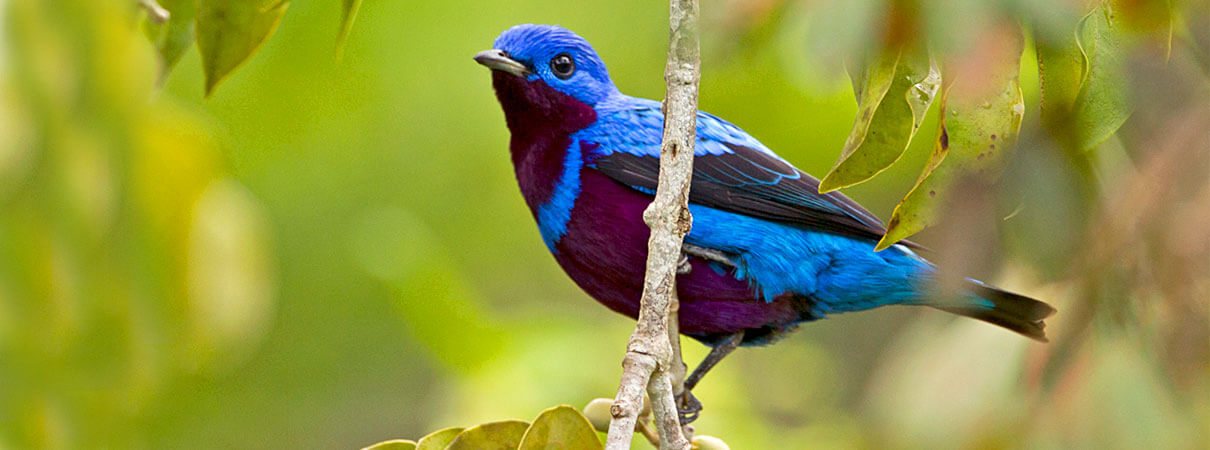
Banded Cotinga. Photo by Ciro Albano
The male Banded Cotinga is a stunning bird decked out in shimmering shades of blue and purple. The female is a much more inconspicuous brown.
Unfortunately, little is known about the life history of the seven birds in the genus Cotinga, which also includes the Lovely and Spangled Cotingas. Although many are strikingly colored, they are shy, unobtrusive birds that dwell high in the forest canopy. There they feed mainly on fruit, perhaps supplemented by seeds and insects.
Like other colorful birds, Banded Cotingas are often trapped for the cage-bird trade, which along with deforestation is one of the main causes of their steep decline. It has been designated as Endangered by the IUCN.
Black-headed Berryeater
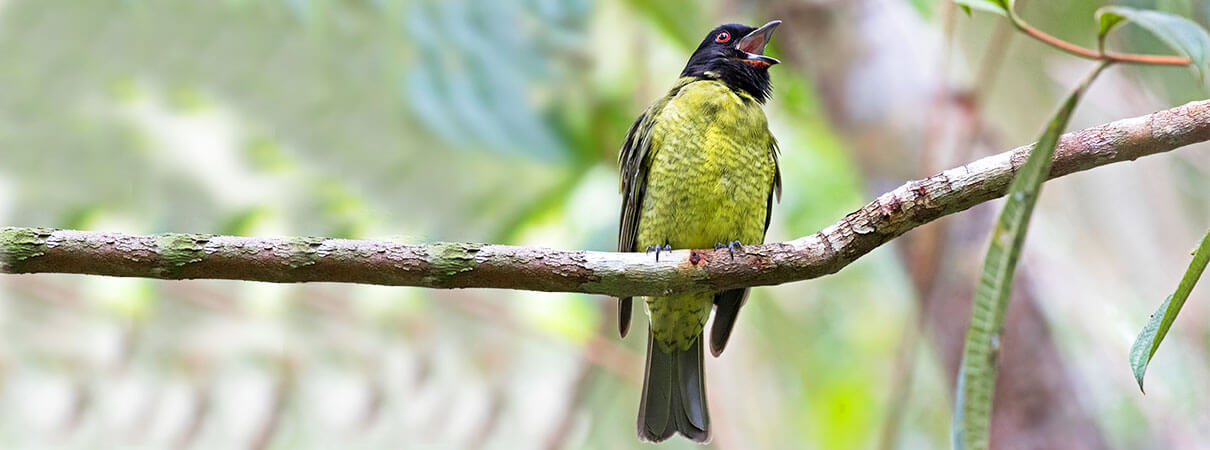
Black-headed Berryeater. Photo by Ciro Albano
True to its name, the Black-headed Berryeater eats mostly fruit; in fact, the birds' frenzied feeding at fruiting trees is one of the best ways to spot this species. Like other members of the cotinga family, it plays an important ecological role by dispersing fruit seeds.
The Black-headed Berryeater's voice — a single note followed by a descending whistle, repeated at regular intervals — is another reliable way to locate this rare bird.
Audio by Roney Souza, XC338134. Accessible at www.xeno-canto.org/338134.
It is closely related to the Hooded Berryeater, another Atlantic Forest endemic, but favors higher elevations and is more threatened. The IUCN has classified the Black-headed Berryeater as Vulnerable because of its small and fragmented population.
Striated Softtail
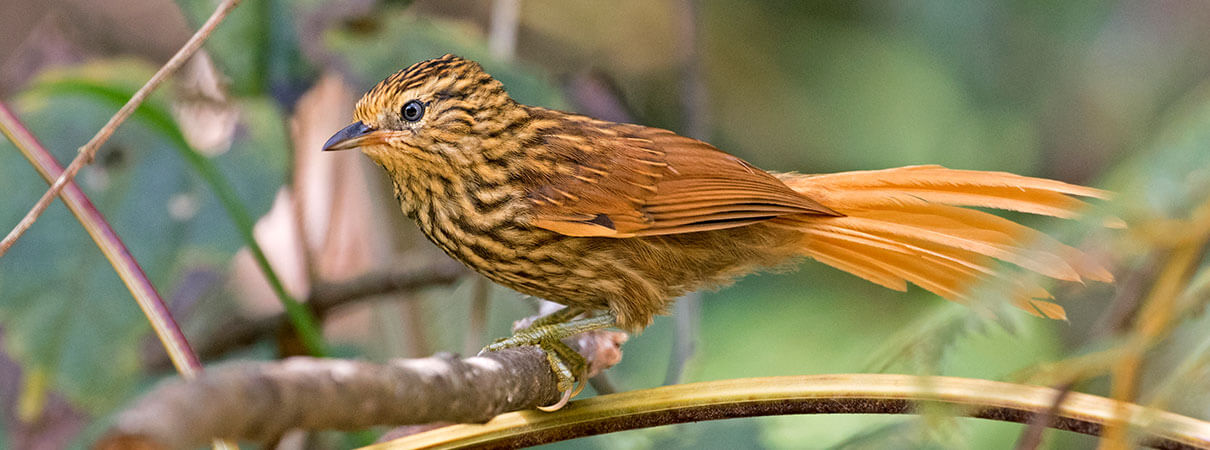
Striated Softtail. Photo by Ciro Albano
This vulnerable endemic species is a member of the Ovenbird family — a large family of birds found only in the tropics of Mexico and Central and South America. (The familiar migratory Ovenbird that breeds in North America is a wood-warbler unrelated to this group.)
The Striated Softtail tends to forage alone or in pairs, usually in the lower and middle levels of humid forest, where it searches for insects in tangled vines. The birds are more likely to be seen in forests where dense vine-tangles are present.
For safety and the chance to capture more prey, occasionally the bird joins mixed-species flocks of other insect-eating birds, including woodcreepers, antshrikes, and antbirds.
Fork-tailed Pygmy-Tyrant

Fork-tailed Pygmy-Tyrant. Photo by Ciro Albano
This tiny, distinctively patterned flycatcher, also known as the Fork-tailed Tody-Tyrant, skulks in the undergrowth of forest borders, especially where there are dense thickets of bamboo and vines. It can survive in degraded forest, but even so, the species is rare, likely numbering fewer than 10,000 individuals.
Like other flycatchers, it feeds on insects, including small caterpillars and katydids plucked from leaves during the birds' short, active flights. With a highpitched, staccato voice, the bird's call is usually repeated in a series of threes. Scientists have not yet discovered other aspects of the bird's behavior and breeding biology.
Audio by Caio Brito, XC427450. Accessible at www.xeno-canto.org/427450.
The Fork-tailed Pygmy-Tyrant is suspected to be declining rapidly, in line with rates of habitat loss within its range. It is another Atlantic Forest endemic that the IUCN has classified as Vulnerable due to extensive, ongoing habitat loss.
Hook-billed Hermit

Hook-billed Hermit. Photo by José Almir Jacomelli Jr.
Hermits are a large group of hummingbirds numbering 30 to 40 specie and ranging from southern Mexico to northern Argentina. The Hook-billed Hermit is among the rarest. With as few as 200 to 300 remaining in the heavily degraded Atlantic Forest, the species is classified as Endangered by IUCN.
The Hook-billed favors humid forest interiors along waterways, particularly streams bordered by the brightly colored flowers of Heliconia plants, which it plays an important role in pollinating. (The shape of some Heliconia flowers limits pollination to a subset of hummingbirds in the region.)
Deforestation and fragmentation caused by roads and human settlement have scattered the Hook-billed Hermit's populations and led to dangerous declines.
Pin-tailed Manakin
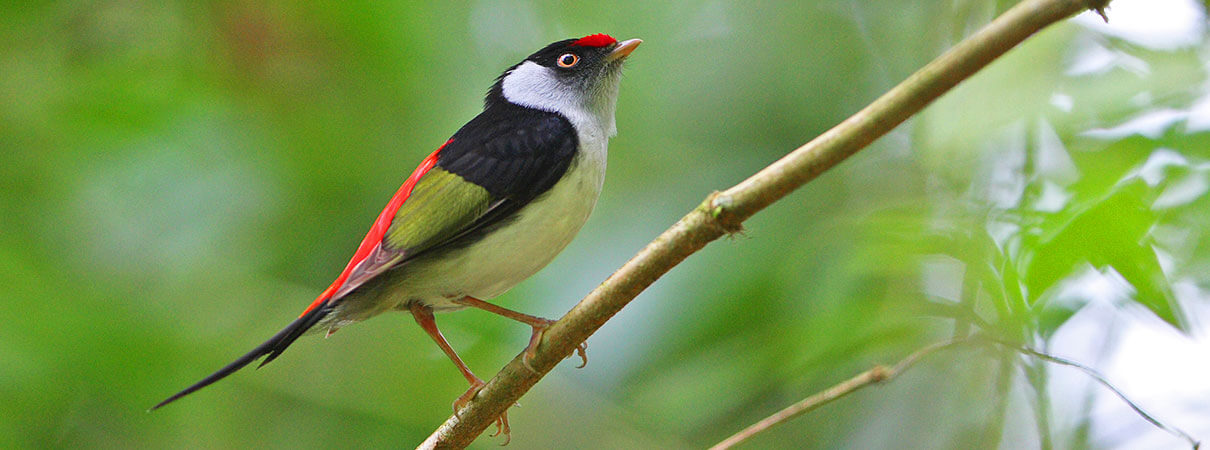
Pin-tailed Manakin. Photo by Ciro Albano
Manakins derive their name from the Middle Dutch mannekijn, which translates to "little man." The Pin-tailed Manakin, found only in the Atlantic Forest, is considered one of the most beautiful. While the male's flashy green, red, and black plumage stands out, the birds are difficult to spot, in part because of their unusually quiet vocalizations.
Like most manakins, the Pin-tailed is sexually dimorphic, with the colorful male far outshining the dull, greenish female. Both sexes have elongated, pointed central tail feathers for which the species is named.
Male manakins are known for their elaborate group courtship displays. These often take place on gathering grounds called leks, where females visit to select a mate.
Maroon-faced Parakeet
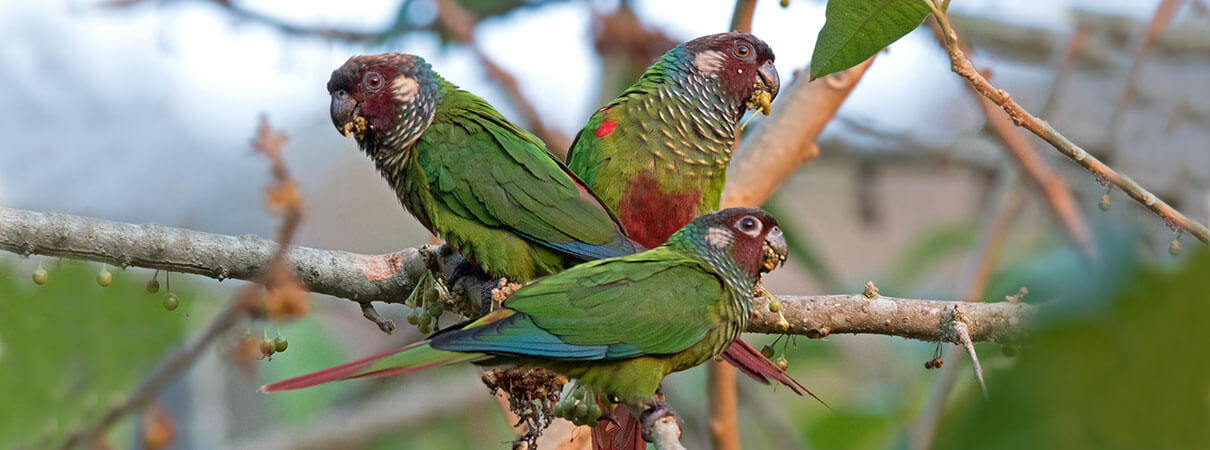
Maroon-faced Parakeet. Photo by Ciro Albano
These small parrots favor the canopy of humid forests, but they can also be found along edges and in clearings with scattered trees. The birds are surprisingly inconspicuous unless they are in flight or uttering their high-pitched, yelping calls. Otherwise, they are well camouflaged by their mottled plumage.
Audio by Ciro Albano, XC57965. Accessible at www.xeno-canto.org/57965.
Also known as the White-eared Parakeet, this bird is closely related to the Venezuelan, Gray-breasted, and Pfrimer's Parakeets, which were formerly considered subspecies of this species.
Like other parrots, Maroon-faced Parakeets nest in tree cavities excavated by other species such as woodpeckers. Outside of the breeding season, they are gregarious, usually seen in groups of 15 to 20 birds.
Bare-throated Bellbird

Bare-throated Bellbird. Photo by Rudimar Narciso Cipriani
The male Bare-throated Bellbird is one of the loudest birds in the world. Sounding off with metallic, two-toned notes, males call from a perch high in the forest canopy during courtship or while defending territory.
Audio by Caio Brito, XC427846. Accessible at www.xeno-canto.org/427846.
Aside from its piercing calls, this striking bellbird is rather inconspicuous. It eats fruit and plays an important role in the ecology of the Atlantic Forest by dispersing seeds. This species appears to be migratory in at least some regions, including southeast Brazil, although this behavior apparently varies among populations.
Along with habitat loss, the pet bird trade has led the International Union for the Conservation of Nature (IUCN) to designate the Bare-throated Bellbird as Vulnerable to extinction.
Three-toed Jacamar

Three-toed Jacamar. Photo by Nick Athanas
Beginning birders sometimes mistake jacamars for hummingbirds. In fact, jacamars are most closely related to puffbirds, another tropical family extending from Mexico through South America.
The Three-toed Jacamar, found in drier areas of the Atlantic Forest, is unusual with its three forward-facing toes and one back-facing toe. Other jacamars have two toes facing forward, two facing back.
This species eats flying insects, expertly snapping up butterflies, dragonflies, and wasps with its long, thin bill. The birds nest in burrows, which the females usually dig in an earthen bank. Although capable of surviving in some degraded habitat, this species is experiencing a major decline, and is considered Vulnerable by the IUCN.


















































